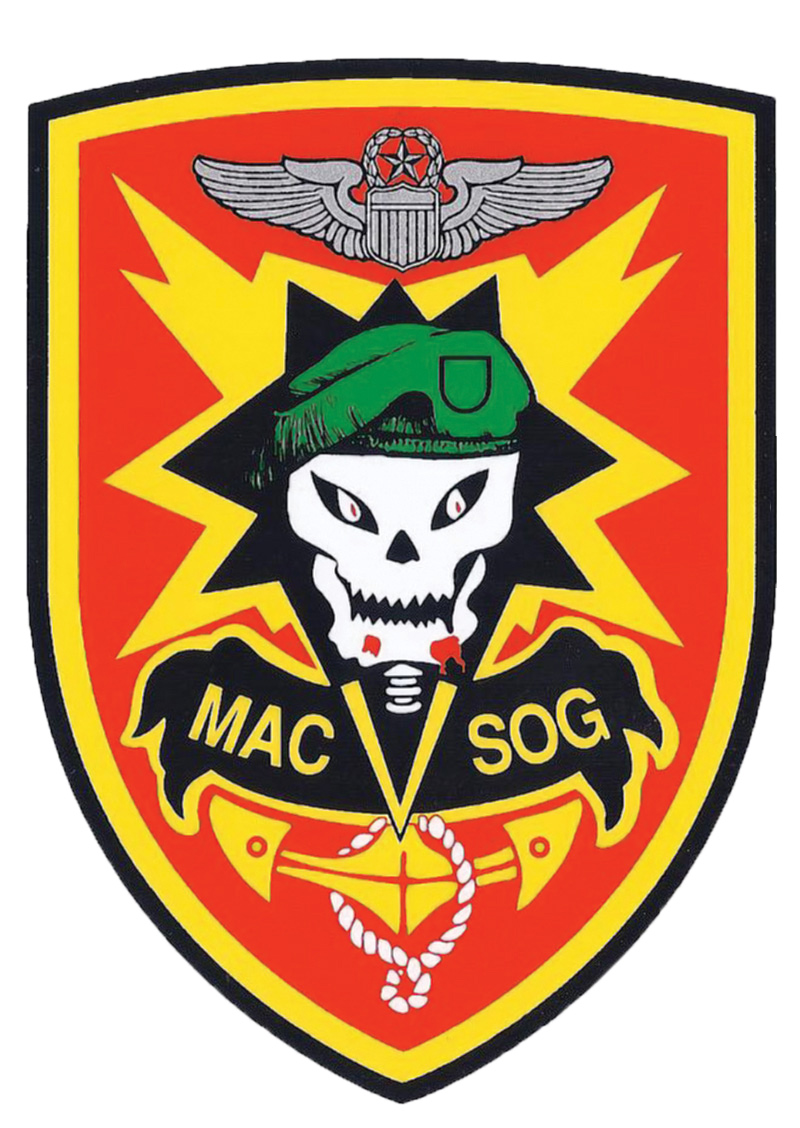
FOB4 Overrun on
August 23, 1968:
Prelude to Becoming the
Commanding Officer of the
MACV-SOG One Zero (1-0) School
By Travis Mills
Originally published in the March 2018 Sentinel
Editor’s Note: This is the story of how then-1st Lt Travis Mills, who was assigned to the Studies and Observations Group, Vietnam, began the MACV-SOG 1-0 School. This first part of a three-part series begins when FOB 4 was assaulted and overrun on 23 August 1968 by the North Vietnamese Army. This has been considered the worst day in terms of casualties for the Special Forces Regiment not only in Vietnam but throughout its storied history. Travis sustained multiple AK-47 gunshot wounds on that day defending the FOB. Parts Two and Three continue with the story of the development and implementation of the MACV-SOG One Zero School, which in March 2018 had never been published before. The story will continue in September with Part Two.
I arrived at FOB 4 in May 1968. I was initially assigned to 2nd Company of the Hatchet Force. Except for me, all the American personnel in 2nd Company were from a TDY team from 1st Group. The TDY team had their own hooch and didn’t have any room for me so I was housed in a hooch on the southeast corner of the Recon area with several other LT’s from 1st Company. I spent a couple of months with 2nd Company. Near the end of June or early July, the TDY team went back to Okinawa, and I was assigned to RT Python as the One-One. I had been on one mission with Python, when CCN restructured Recon Company. Python’s One-Zero was only a week or so from rotating, and the FOB 4 Teams were being consolidated, so Python was deactivated, and I was assigned to Team Coral as the One-One. The One-Zero (SSG Hatcher) was scheduled to rotate in about six weeks and I was to be trained and checked out to take over as the One-Zero. The One-Two was a SGT Podlaski. I ran 3 missions with Coral as the One-One, then in mid-August, Hatcher rotated and I was moved up to One-Zero. We were given a week to train then go back on the target list.
The days leading up to the 22nd and the 23rd were rather uneventful. We were doing the typical training routines of IA drills, movement drills, team gear lists, etc, etc. After we finished training on the 22nd, I took a shower and went to the mess hall. Podlaski and I talked about the team members (he had been on the team with Hatcher for about 4 months and was very familiar with the team members), potential upcoming missions, and team strategy. After dinner, he went to find a poker game, and as I was coming out of the mess hall, they were setting up for a movie, so I wandered over to “theater” (benches on the North side of the mess hall) to check out the movie. It was In Cold Blood. I had read the book but had not seen the movie, so I decided to stay. The last scene was Perry hanging at the end of the noose and the only sound was the slowing “thump” of his dying heart – then silence. It was a very powerful scene and I had no idea how prophetic it would be in just a few hours.
When I got back to the hooch, Geoff Fullen, Dave Carr, Ron Crabbe, and another person I don’t remember (might have been Phil Bauso) had a hot pinochle game going. I went to the other side of the hooch and talked for a little while with Bob Blatherwick. After a little while the pinochle game broke up and everyone was getting ready to hit the bunk. Geoff and I went out to the “piss tube” and as we were standing there we noticed a lot more flares up from the Marines to the South and to the North. We heard some muffled explosions to the North toward MCAS. Geoff commented, “Looks like the marines are catching hell tonight”. I agreed and we went back to the hooch to call it a night. My bunk was perpendicular to the center partition in the hooch. I had a couple of nails in the wall just above my bunk where my CAR15 and web harness hung within easy reach. Boots on the left side of the bunk and trousers and shirt on nails just to the left of my weapon and web gear. After a good day of training and feeling very confident about the team and an uneventful evening, I drifted off to sleep thinking all is well and looking forward to receiving our target assignment.
The next thing I remember was a tremendous explosion. Later I would learn it was a satchel charge that had been thrown into the hooch next to ours. That explosion was followed by several more. I had not heard any small arms fire, so I thought we were under a mortar attack. I immediately rolled out of the bunk, grabbed my trousers, shoved my feet into my boots, just did a quick tie, grabbed my web gear, CAR15 and headed for the back door (east) to my (the team) assigned defensive position along the beach. As I went through the partition to the other side of the hooch, Ron Crabbe fell in behind me and as we approached the back door, Geoff fell in behind Crabbe. We were all headed for our defensive positions.
I was first out the door. It was totally dark, but the white sand of the FOB and other objects contrast made visibility and recognition reasonable. Just as I cleared the door, out of the right corner of my vision I saw an indigenous person at the corner of the hooch (about 8 feet). We had 500+ indigenous (nungs & yards), in the camp and my immediate thought was he was heading to his defensive position also. I hesitated for half a second, then I saw the muzzle flash. He fired a blast of full automatic. The first round hit me it the stomach, entering on the right side, exiting on the left. The force of impact spun me around and I fell with my head about a foot from the bottom step of the hooch. As he continued to fire, it moved to his left and hit Crabbe who was on the top of the steps, knocking him back into the hooch. As Crabbe fell back into the hooch, he knocked Geoff back into the hooch.
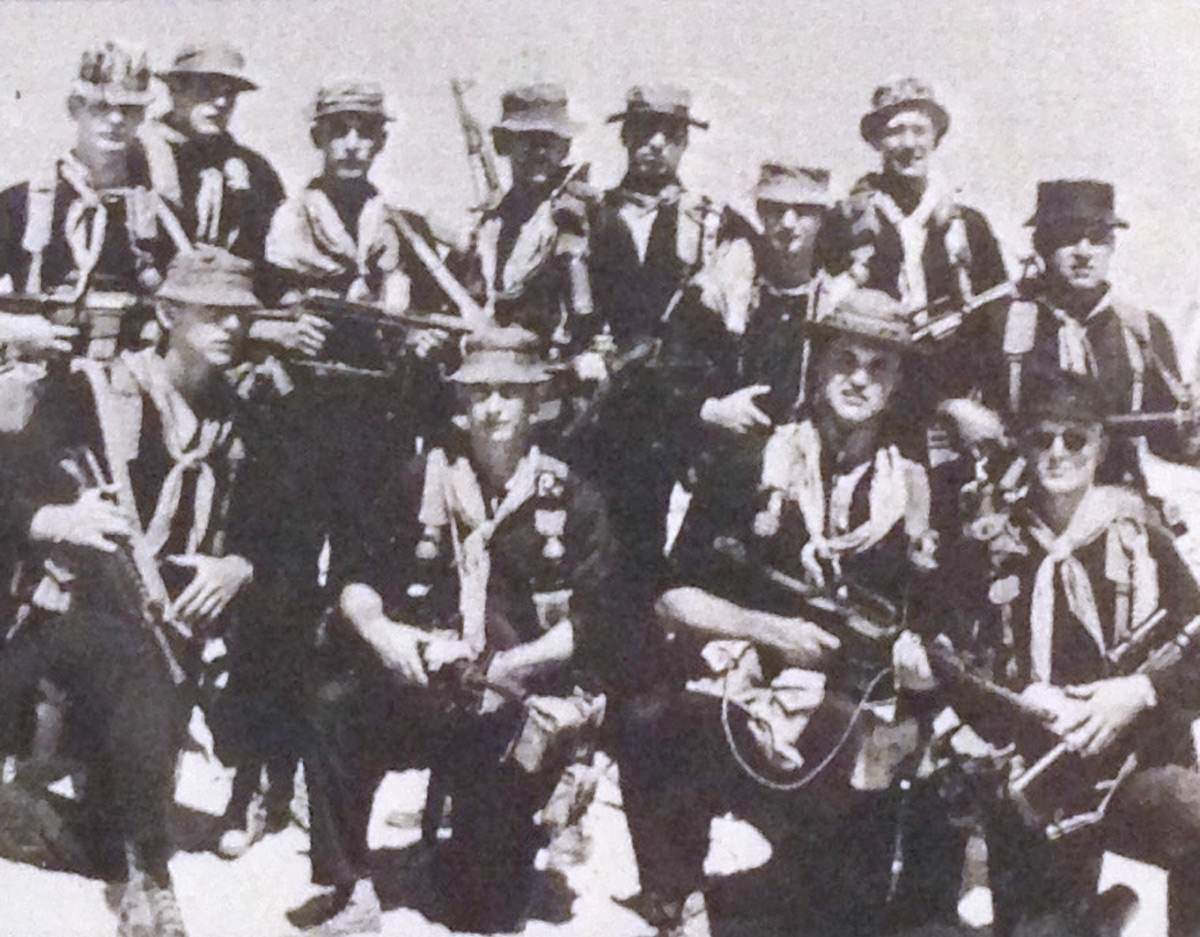
FOB 4 Hatchet Force — Travis Mills 2nd from the left on the front row
My first reaction was I WAS PISSED! My immediate thought was I had been shot by one of our own guys – I WAS PISSED!. My first action was to try to get up and yell at him, “You son-of-a-bitch – I’m an American!” His reaction was he shot me again! This time he hit me in the arm; I went down again. Now I’m REALLY PISSED! I’m going to shoot this bastard, I don’t care if he is a friendly, so I start to get up again, and the same result, he shoots me again! This time he hits me just under the shoulder blade. So I try to get up again, he hits me in the back of the head; down on the sand again. One more time I’m going to get up and shoot this bastard – one more time he fires – this time in the back of the neck. FINALLY – I get the message – he knows who you are and he’s still trying to kill you! So I finally come to the obvious conclusion – if you stop trying to get up maybe he’ll stop shooting you. (Brilliant deduction Dr. Watson). So I layed still with my head facing him. (Although it took me several minutes to write this – it all happened in about 10 to 15 seconds). He walked over, stood over me with one foot on each side of my head. Although I couldn’t see him, I knew he had the muzzle pointed directly at my head for the kill shot.
At that time, I came to one of the most memorable moments in my life. It is so hard to explain and/or understand, but every person who has been there will understand completely. At that moment, looking at his bare foot, I said to myself – “So this is what it’s like to die”. At the same moment I in my mind I saw the final scene of In Cold Blood with Perry’s final heartbeat – Thump – Thump – thump – Silence! I had absolutely no pain – I was totally amazed at the calm that settled over me.
At that precise second, a loud commotion occurred in the hooch. The sapper immediately ignored me and spun around, stepped to the door of the hooch and sprayed the hooch on full automatic. I think most everyone was on the floor, except Geoff, who got hit in the hand. After he emptied his magazine, he casually walked to the south corner of the hooch (putting in a new magazine). I watched as he got to the corner, kneeled down so he could see back around the corner to watch the back door of the hooch.
Inside the hooch, they were trying to attend to Crabbe. His femoral artery had been hit and he was bleeding profusely. After 30 seconds or a minute, Bob Blatherwick came to the door. He was coming to get me. Without moving and trying to use the best “stage whisper” I could, I told him “Bob – don’t come out!” Bob stopped and hunkered down in the door. He said: “What’s up Trav?” I said; “He’s right there on the corner, waiting for you.” Bob leaned out, looked to the South and said: “I don’t see anything.” I said: “Do you see a sandbag about 3 sandbags up that sticking out further that the other sandbags?” Bob leaned out of the door and said “ yeah”. I said:” Shoot it!”. Bob said: “You want me to shoot a sand bag?’ I replied in a strong stage whisper: “ Shoot the f—ing sandbag!” He said: “OK, OK, OK!” So Bob leaned out the door, lined his M16 down the edge of the sandbags and fired a burst. When he fired the burst, I got up, grabbed my CAR15 and got back in the hooch. (Later on, when I got back from the hospital – I was told he (the sapper) was found with a bullet through his forehead – apparently he was looking right down the barrel when Bob squeezed the trigger.)
Once back in the hooch, Geoff kept reassuring me I was going to be OK. Once he finally convinced me I was going to live, the pain kicked in big time. I remember asking Geoff, “Have you ever eaten a bunch of green apples?” “Damn, it hurts!”
All of a sudden, we heard “Don’t shoot, We’re comin’ in” It was Charlie Pheifer (CPT) coming through the front (west door). He said: “The little bastards are everywhere” I need a gun, mine is jammed – I gave him my CAR15 and he gave me his Browning 9MM. With that he went out the front door.
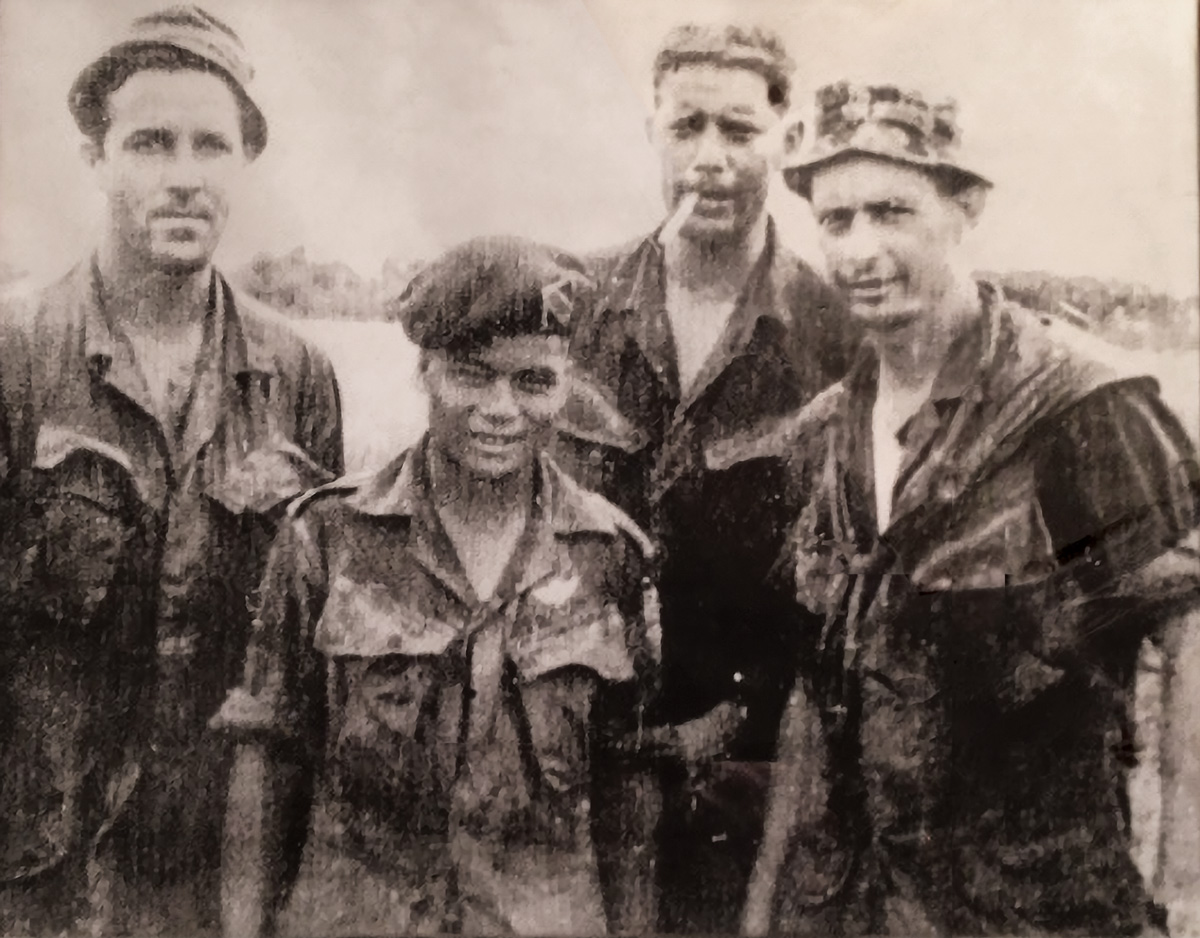
Taken during the training of the Hatchet Force Company. Left to right, – Charley Miller, Tahan the interpreter, Jim Hectrick, and Travis Mills. Please notice Tahan has sweated through his shirt — when the “Yards” sweat IT IS HOT!!!
Somebody said, “We gotta get out of this hooch”. There was a mortar pit just a few meters from the back (east) door of our hooch. We got out to the mortar pit. There were a couple of NCO’s in the pit putting up illumination. We got in the pit, Geoff started pulling charges, handing them to me, and I passed them on to the gunners. One of the NCO’s (I don’t remember his name) found a compression bandage and put it on my stomach wound to help control the bleeding and relieve the pressure. Also I discover I had no feeling and limited use of my right hand. The shot through the arm had severed some of the nerves. I could use the forefinger and thumb, but the rest of the fingers were unresponsive, but the left arm and hand were OK, so I passed the rounds with my left hand. After a little while, who knows the actual time frame, Bob Blatherwick showed up in a jeep, he picked up Crabbe and took him to the dispensary. When he left, he said, “Trav, I’ll be back.”
We continued to put up ilum rounds, at some time later, Bob came back – I got in the jeep and just as we left Bob told the guys in the pit, “Keep the flares going, they shot the lights out on the jeep and I need the flares to find my way around.” It was surreal ride through the camp. The old TOC was a crumpled, blazing pile of rubble. There were sporadic gunfights around various buildings, buildings on fire, and the weird dancing shadows from the flares swinging under their parachutes. A couple of times we heard the crack of a round passing close by, but we made it to the dispensary OK. Bob slid to a stop, as I was getting out he said, “Take care Trav, see you later”. With that he raced off into the dark looking for more wounded.
When I entered the dispensary, it was organized chaos. One of the medics checked me out, put a large, ace bandage type of wrap around me. The pressure really slowed the bleeding and the support eased the pain somewhat. He put me in the “waiting room”, told me to watch the back door, and they would get to me as soon as they could. They had some guys in really bad shape that needed their attention. So I pushed a couple of chairs together, laid down across them so I could see the back door, and as long as I didn’t make any quick movements, I was reasonably comfortable.
In the meantime, one of the really critical guys was Scully. He was one of the senior medics. He had been hit at the base of his skull. The medics were working frantically over him. I heard one of them say, “If we don’t get him to a hospital soon, he’s not going to make it.” Another said, “It’s too hot to get a medivac in. What other options do we have?” Someone said, “We’ve got the old cracker box ambulance – we could try to get him into the Naval Hospital down the road. How’s the road to MCAS?” Someone said, “Totally unsecure, but it’s our only option.” One of the medics volunteered to drive the ambulance. One of the medics came to me and asked if I would ride “shotgun” to try to get Scully to the hospital. I said, “Sure, let’s go.” So they loaded Scully and a couple more of the critical wounded in the back, the medic drove, I was in the right seat. I gave the driver my 9mm, I took his M16. Just as we were going out the gate he looked at me and said, “I sure hope they don’t want to waste a good ambush on one raggedy old cracker box ambulance”. With that, we made the right turn out of gate for the 3 mile trip to the hospital. I don’t remember his name or what his background was before the military, but he would have done any NASCAR driver proud. I never thought that old cracker box could go that fast.
As we barreled down the road the ambulance took a few rounds but no one was hit. Our next biggest concern was the Marine check point/roadblock at MCAS. We didn’t know how they would react to a vehicle racing down the road toward them in the dark. Normally, once the roadblock was set up every night, the road was closed – so any traffic was considered unfriendly. When we thought we were getting close, the driver started flashing the lights; I hung out the window yelling as loud as I could, “Americans! Americans!” I guess the strategy worked – they didn’t shoot. After a brief stop, they let us through and the rest of the trip was uneventful.
They immediately took Scully and the other guys into the emergency area. (I learned later that Scully and the others all survived) They checked me over and said the bleeding was pretty much under control and I would have to wait to get into the OR. I was put on a stretcher on some sawhorses to wait my turn. As long as I stayed still it didn’t hurt too bad. I spent a few hours there, and as daylight came, more and more wounded arrived. Pretty soon, one of the nurses told me there were too many casualties coming in and they were going to move me to Monkey Mountain Hospital. Shortly, me and 5 others were loaded on a marine helicopter and taken to Monkey Mountain Hospital. Upon arrival I went through the triage again and was put in the queue. Again a long wait, but finally my turn for the OR came.
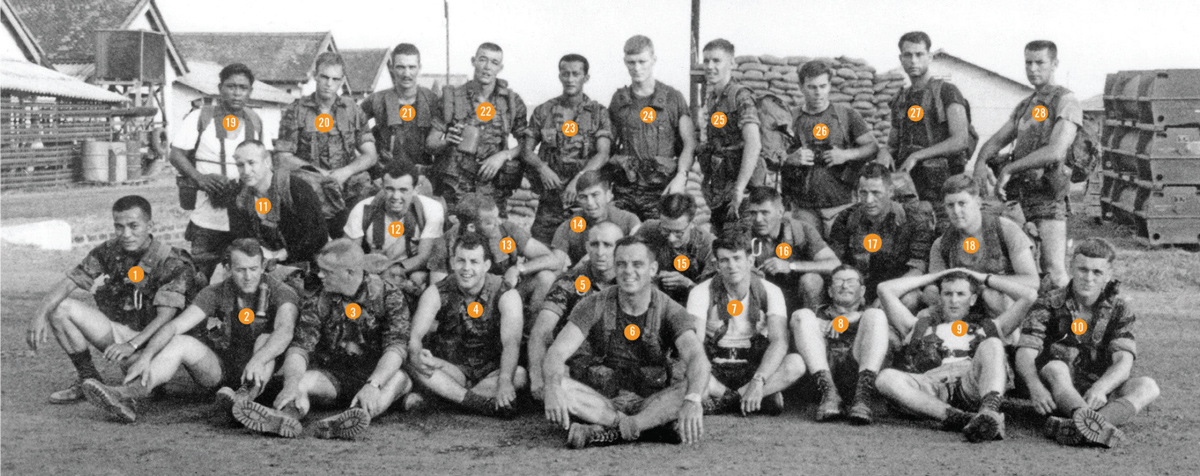
Snakebite Team One — Identified members in the above photo are: 2. Bill Werther, 3. Eulis Presley, 5. Alton “Moose” Monroe, 4. Gerald Wareing, 12. Angel Stabolito, 15. Richard Lavoie, 16. Asa Ballard, 17. Henry Jennings, 18. John Cummings, 21 Larry White, 22. Artenis “Bill” Arbogast
The next thing I knew, I was waking up in the recovery ward. I had a big bandage that covered most of my stomach, my right arm tied down to my chest, and bandages on my back and neck. As I continued to become more awake I began thinking of the events of the previous hours and started to get into a depressive mood. Again, looking at all the bandages, having only the use of my left hand, I started sinking into the “Why me?” and “What did I do to deserve this?” mode of self pity. About the time I was really starting to feel sorry for myself, I had one of the most profound experiences of my life. They wheeled a young Marine out of the OR and put him next to me in the recovery area. When you are coming out from under the anesthesia, you go through all kinds of wild talking, yelling, and sometimes fighting. This young Marine was going through all types of gyrations and shouting “They’re in the wire! – They’re coming over the wall!”. During his gyrations he kicked off the sheet. When I looked at him he had his right arm gone just above the elbow, and both legs gone, one below the knee and the other above the knee. At moment I heard my grandmother’s voice a clear as a bell – “I used to complain that I had no shoes until I met a man that had no feet”. At that instant my depression vanished and I realized how fortunate I was. I resolved to get healed up, get back to camp and back in the fight. I don’t know that young Marine’s name, or anything about him, but hardly a day goes by that I don’t think of him and the challenges he faced. I will never forget him and I wish him well.
Shortly after that incident some staff member checked my alertness and said they were still getting more wounded and they didn’t have anywhere to put me, so I would be going to the hospital ship. Me and several others were strapped on stretchers and loaded into a marine helicopter and after a short flight, landed on the helipad of the USS Sanctuary, It would be my residence for the next 31 days.
After I had been there a few days I found out just how fortunate I was. The doctor explained my wounds and treatment plan. The stomach wound was the major one. Because I had been coming out the door and was sideways to the sapper, the round hit me in the right side, penetrated under the skin, went across my stomach, and exited out the left side. It totally ripped all the stomach muscles away, but because he was so close and the bullet was still quite stable, the stomach wall had a “burn” mark all the way across. It didn’t penetrate the stomach and therefore none of the bacteria, acids, etc., spilled out. Had that happened, he said I would never have survived the infection. The arm wound was a clean, through and through wound. It did destroy most of the nerve tissue and I would most likely have limited use of my right hand. The bullet had missed the bone by 2mm. Had it hit the bone, it would have most likely severed the arm and I probably would have had a low chance to survive the shock and loss of blood. The shoulder blade wound didn’t penetrate very deep, again because I was sideways to him when he shot and it was mainly just muscle and tissue damage. The neck wound missed my spinal cord by just a few mm’s. Obviously if it had hit the spinal cord it would have been a devastating injury, but as it was, it was just severe tissue damage. The doctor surmised that I was one of the luckiest people on this planet.
On the ship, there isn’t much to do, so I had a lot of time to think. As I analyzed his almost missing me with most of his shots I came to the conclusion two factors weighed heavily on that outcome. First, he was quite close, less that 10 feet and second, he was firing on auto. We all know that with a high velocity rifle, the round comes out high (remember the zero range). I think when he aimed and fired, the first round came out high and just barely hit me. He was firing on auto, so the AK climbs, and the other rounds of the burst went over me.
The regulations limit the stay on a hospital ship to 31 days. After that there are two options: return to duty or further evacuation. All my wounds were healing well, and I was aggressively pursuing the rehab. The biggest issue was the nerve damage in my right arm and limited use of my right hand. I was determined to return to camp. As the 31st day neared, I continued to lobby the doctor to sign off on my return to duty, but he was steadfast in sending me to Japan for further rehab. After squeezing a tennis ball for weeks and in total desperation on the day of decision, I played my best card. I demonstrated to him I had almost full use of my forefinger and thumb and that’s all I needed to pull the trigger, therefore I should be declared eligible for return to duty. He said, “I have never seen anyone as stubborn as you. If that’s what you really want to do, then it’s OK with me.”
The next day the USS Sanctuary pulled into Da Nang harbor, loaded a bunch of us in a launch and ferried us to the dock. I found a marine truck headed for MCAS and hitched a ride. Once at MCAS, FOB 4 was just a few miles down the road so I started walking south and soon got a ride with a truck going that way. They let me off at the front gate.
When I arrived on the Sanctuary my only clothing was a bloody surgical sheet. The Navy issued me a set of “dungarees” when I was discharged. The guards at the gate were not really sure about this strange sailor showing up at the front gate. I finally convinced them to call the TOC. When someone answered the phone, I said in my best command voice, “1LT Travis Mills, reporting for duty!”
In a few minutes a LT arrived at the gate, signed me in and took me to the mess hall. It was noon meal time. It was a bittersweet reception. Seeing old friends and learning of the ones that were gone. My old hooch was now occupied by new guys and all my stuff was in a foot locker in supply waiting to be shipped back to the states. I was assigned a room in the transient quarters. The next day I went to the S-1 and S-3 to see about getting back on the team and getting back in the game, but life had other plans.
But, that’s a whole ‘nother story…
About the Author:
Travis Mills enlisted in the U.S. Army, June 1966 — Basic and Infantry AIT. Following AIT Pvt. Travis was assigned as cadre in a basic training unit where he was promoted to Corporal. He then attended OCS at Fort Benning, GA, graduating as the Honor and Distinguished Graduate. 2nd Lt Mills next attended Jump School and was then assigned to the 7th SFGA at Fort Bragg, NC, where he completed the Special Forces Officers Course and then served as XO on an A-Team.
Receiving orders transferring him to Vietnam where he arrived in May 1968 and was assigned to 5th SFGA. Then 1st Lt Mills was assigned to MACV-SOG Command and Control in Da Nang, then to FOB 4 at Marble Mountain. Initially assigned as a platoon leader of the Hatchet Force, he was later transferred to the Recon Company and served as 1-1, 1-0 on RT Python and RT Coral.
Following discharge from the hospital for his serious wounds on August 23, 1st LT Mills was assigned TDY to B-53 in Long Thanh to start the MACV-SOG One Zero (1-0) School. In June 1969 LT Mills was promoted to Captain. In December 1969 he was reassigned to 1st SFGA in Okinawa where he spent thirty months as an A-Team Commander on various missions to Korea, Taiwan, the Philippine Islands and Japan. While stationed in Okinawa he graduated from Jump Master School.
In July 1972 Captain Mills was assigned to Fort Hood, Texas. With the down sizing of the Army after the withdrawal from Vietnam Captain Mills was released from active duty and honorably discharged on November 1973.
Awards and Decorations
Bronze Star Medal, Purple Heart, CIB, Presidential Unit Citation (MACV-SOG), Vietnam, Chinese and Korean Jump Wings and the “usual” decorations and badges.
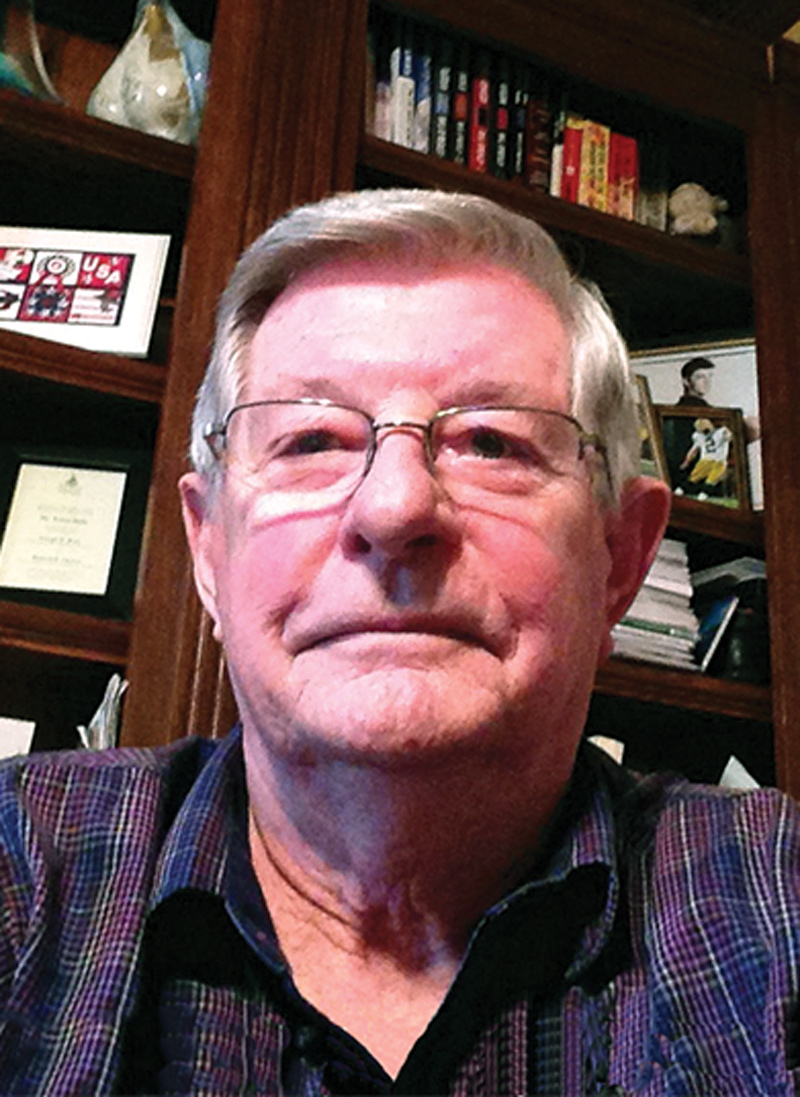
In the Snakebite Team 1 photo, Nr 9 is Bill Clancy.
Outstanding service to the mission